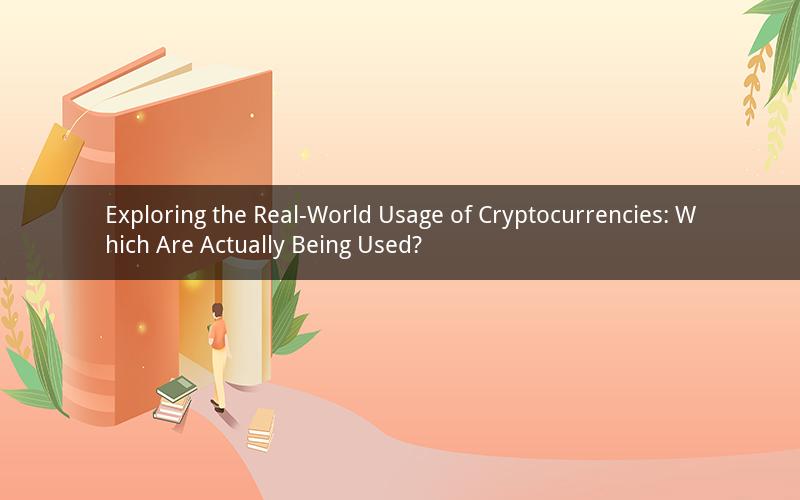
Introduction:
The world of cryptocurrencies has been rapidly evolving since the inception of Bitcoin in 2009. With numerous cryptocurrencies flooding the market, it can be challenging to discern which ones are actually being used in real-world transactions. In this article, we will delve into the most widely used cryptocurrencies and explore their practical applications.
1. Bitcoin (BTC):
As the pioneer of the cryptocurrency revolution, Bitcoin remains the most popular and widely recognized cryptocurrency. Its decentralized nature and limited supply have made it a preferred choice for various real-world transactions. Bitcoin is accepted by numerous online and physical retailers, as well as some governments, for payments and investments.
2. Ethereum (ETH):
Ethereum, launched in 2015, is the second-largest cryptocurrency by market capitalization. It stands out for its smart contract functionality, enabling developers to create decentralized applications (DApps) and decentralized finance (DeFi) platforms. Ethereum is widely used for real-world applications, including NFTs (non-fungible tokens), supply chain management, and decentralized exchanges.
3. Ripple (XRP):
Ripple, a blockchain-based payment protocol, aims to facilitate cross-border transactions. Its primary use case is in the financial industry, where RippleNet has been adopted by various banks and financial institutions. Ripple is known for its high-speed and low-cost transactions, making it a preferred choice for international money transfers.
4. Litecoin (LTC):
Litecoin, launched in 2011, is often considered the "silver" to Bitcoin's "gold." It offers faster transaction confirmation times and a larger supply cap compared to Bitcoin. Litecoin is used for various real-world applications, including online purchases, payment processing, and as a medium of exchange in certain countries.
5. Binance Coin (BNB):
Binance Coin, the native token of the Binance exchange, has gained significant traction in the cryptocurrency space. It is primarily used for paying transaction fees on the Binance platform, as well as for various other applications, such as purchasing goods and services, participating in governance, and accessing exclusive features.
6. Cardano (ADA):
Cardano, founded in 2015, is a blockchain platform that aims to offer a more sustainable and scalable solution compared to existing cryptocurrencies. It is used for various real-world applications, including financial services, identity verification, and voting systems.
7. Dogecoin (DOGE):
Dogecoin, a cryptocurrency based on a popular internet meme, has gained a massive following and is now used for various real-world applications. It is accepted by some online retailers, as well as used for tipping content creators and influencers.
8. Tether (USDT):
Tether is a stablecoin that aims to maintain a 1:1 ratio with the US dollar. It is widely used for trading, as a medium of exchange, and as a store of value. Tether is particularly popular among cryptocurrency traders and investors, as it provides a stable alternative to volatile cryptocurrencies.
9. Polkadot (DOT):
Polkadot is a blockchain platform that aims to enable interoperability between different blockchains. It is used for various real-world applications, including cross-chain transactions, decentralized finance, and decentralized identity solutions.
10. Chainlink (LINK):
Chainlink is a decentralized oracle network that connects smart contracts to real-world data. It is used for various real-world applications, including decentralized finance, insurance, and supply chain management.
Questions and Answers:
1. Q: Why is Bitcoin still the most widely used cryptocurrency?
A: Bitcoin's first-mover advantage, decentralized nature, and widespread acceptance have made it the most popular cryptocurrency. Its status as a digital gold has also contributed to its widespread usage.
2. Q: What sets Ethereum apart from other cryptocurrencies?
A: Ethereum stands out for its smart contract functionality, which enables the creation of decentralized applications and platforms. This has made it a preferred choice for developers and businesses looking to leverage blockchain technology.
3. Q: How does Ripple differ from other cryptocurrencies in terms of real-world usage?
A: Ripple focuses on facilitating cross-border transactions and has been adopted by various banks and financial institutions. Its high-speed and low-cost transactions make it a preferred choice for international money transfers.
4. Q: Why is Dogecoin gaining popularity in the real world?
A: Dogecoin's widespread adoption is driven by its fun and community-driven nature. Its acceptance by some online retailers and influencers has further contributed to its popularity.
5. Q: How does Tether provide stability in the cryptocurrency market?
A: Tether maintains a 1:1 ratio with the US dollar, making it a stable alternative to volatile cryptocurrencies. This stability makes it a preferred choice for traders and investors looking to mitigate risks associated with cryptocurrency volatility.